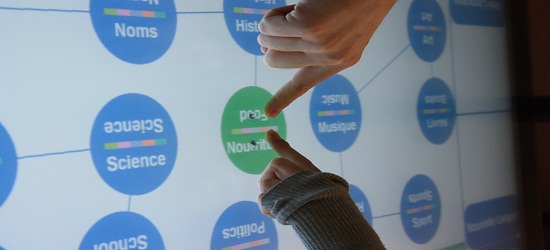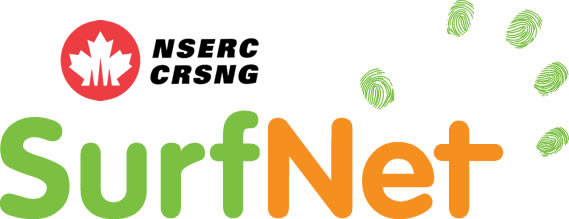TandemTable: Collaborative Language Learning using a Multi-Touch Digital Tabletop
Description
In tandem language learning, two or more people of differing native tongues, interact and communicate to transfer language knowledge. To help co-located tandem language learners communicate and make the most of their learning sessions, we have created a computer-assisted language learning system designed for a multi-touch tabletop. Our system, called TandemTable, suggests topics of discussion along with associated activities that consist of topic related shared digital artifacts. Since tandem language learning is heavily dependent on communication, the system’s purpose is to help mitigate the diminishing in quality and in length of such communication. It achieves this by inspiring conversations and helping them flow through the use of the suggested topics and shared content.
 Figure 1: Tandem language learners selecting a topic of discussion.
Figure 1: Tandem language learners selecting a topic of discussion.
To make the learning session a more comfortable setting for learners, our system includes an introduction phase where learners are prompted to ask each other non-invasive personal questions, and how they can help their partner reach their learning goals. In regards to content, our system consists of five digital media activities: Twitter, News Headlines, Photos, Videos, and a word-to-picture matching game. All content is downloaded from the internet in real-time to give learners up-to-date learning material that is different from one session to the next. To help understand confusing content, learners can select words for highlighting, which will place them in the centre of the screen for discussion, and allow them to be automatically translated
Visit the vialab’s website for more information: http://vialab.science.uoit.ca/portfolio/tandemtable
Researchers
-
Erik Paluka – http://www.erikpaluka.com
-
Christopher Collins - http://vialab.science.uoit.ca/portfolio/christopher-m-collins
Publications
-
Erik Paluka and Christopher Collins. 2013. Augmenting tandem language learning with the TandemTable. In Proceedings of the 2013 ACM international conference on Interactive tabletops and surfaces (ITS ’13).
Application Areas
-
Learning, Gaming, New Media and Digital Homes
Themes
-
Humanizing the Digital Interface
-
Understanding the Fit Between Surfaces, Humans, and Human Activity
-
1.1.2 Surface Social Interaction Fundamentals
Interacting with a Single Surface
-
1.2.3 Information Organization and Sharing
-
1.2.4 Surface Orientation
-
Adapting Interface Concepts to Real-world Settings
-
1.4.1 Application Interfaces for Different People and Activities
Partners




